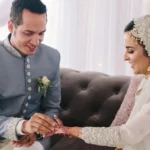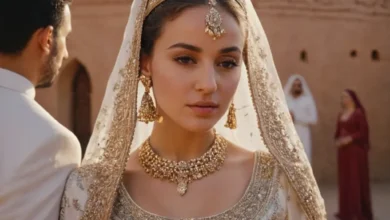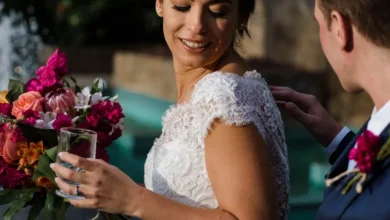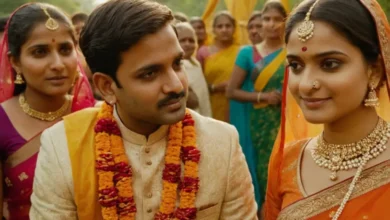Planning a wedding? Dreaming of a day filled with tradition and enchantment? Then a Celtic wedding gown might be perfect for you! This article explores the captivating world of Celtic-inspired bridal wear, offering insights into its history, common features, and tips for choosing the perfect dress to celebrate your love story.

What Makes a Wedding Gown “Celtic”?
The term “Celtic wedding gown” isn’t about a specific, rigidly defined style. Instead, it refers to gowns that draw inspiration from Celtic history, art, and symbolism. Think flowing fabrics, intricate knotwork, and a deep connection to nature. Let’s break down some key elements:
Key Elements of Celtic Wedding Gowns
- Flowing Fabrics: Many Celtic wedding gowns feature fabrics like linen, velvet, and even wool (especially for cooler weather weddings). These materials contribute to a sense of timelessness and connection to the earth. Think soft textures and comfortable silhouettes.
- Intricate Knotwork: Perhaps the most recognizable Celtic motif, knotwork symbolizes eternity and interconnectedness – perfect for representing a lifelong commitment. This can be incorporated through embroidery, lace, or even jewelry.
- Natural Colors: While traditional white is still popular, many brides opt for colors inspired by nature, such as ivory, cream, sage green, heather purple, or even subtle shades of brown. These earthy tones add to the gown’s overall Celtic feel.
- Symbolic Embellishments: Look for embellishments that carry Celtic meaning, such as:
- Triskeles: Representing the three realms (earth, sea, and sky) or the maiden, mother, and crone.
- Claddagh Symbols: Representing love, loyalty, and friendship.
- Animals: Certain animals, like stags and ravens, hold symbolic significance in Celtic mythology.
- Thistles: A symbol of Scotland, often used in Scottish-Celtic designs.
- Loose Silhouettes: While form-fitting gowns are certainly beautiful, many Celtic wedding gowns favor looser, more flowing silhouettes that evoke a sense of freedom and natural grace. Empire waists and A-line skirts are popular choices.

A Brief History of Celtic Wedding Attire (or Lack Thereof!)
It’s important to understand that what we consider “Celtic wedding gowns” today are largely romanticized interpretations of the past. Historically, ancient Celtic wedding attire wasn’t as elaborate as modern gowns. In fact, detailed records are scarce. Most people wore their best clothing, which would have been practical and functional. Think simple tunics and cloaks, often made from wool or linen, and dyed with natural pigments.
The modern interpretation of Celtic wedding gowns draws inspiration from Celtic art, mythology, and general romanticized notions of the past, rather than strictly adhering to historical accuracy. This allows for creative freedom and the incorporation of beautiful, meaningful details that resonate with contemporary brides.
See also Arab Weddings: The Mystique of Cultural Splendor
Arab Weddings: The Mystique of Cultural Splendor
Choosing the Perfect Celtic Wedding Gown: A Step-by-Step Guide
Finding the perfect dress is a personal journey. Here’s a step-by-step guide to help you navigate the world of Celtic wedding gowns:

Step 1: Define Your Vision
Before you even start browsing, take some time to define your vision for your wedding day. Ask yourself these questions:
- What kind of atmosphere do you want to create? (e.g., rustic, ethereal, formal)
- What colors are you drawn to?
- What elements of Celtic culture resonate with you the most?
- What silhouette flatters your body type?
- What’s your budget?
Answering these questions will help you narrow down your options and communicate your preferences to designers or bridal consultants.
Step 2: Research and Inspiration
Gather inspiration! Browse online retailers, bridal magazines, and Pinterest boards dedicated to Celtic wedding gowns. Pay attention to the details that catch your eye. Do you love intricate embroidery? Are you drawn to flowing sleeves? Do you prefer a specific color palette? Save images of gowns that you like to create a visual mood board.
See also The Vibrant Beauty of Brazilian Wedding Dresses: Tradition, Culture, and Modern Flair
The Vibrant Beauty of Brazilian Wedding Dresses: Tradition, Culture, and Modern Flair
Also, research Celtic symbols and their meanings. This will help you incorporate meaningful elements into your dress design.
Step 3: Consider the Fabric
The fabric of your gown will greatly influence its overall look and feel. Consider the season and location of your wedding when making your fabric choice:
- Linen: Lightweight and breathable, perfect for warm weather weddings. It has a rustic, natural look.
- Velvet: Luxurious and rich, ideal for cooler weather weddings. It adds a touch of elegance and drama.
- Wool: A warm and durable option, especially suitable for Scottish-themed weddings. Can be surprisingly comfortable.
- Silk: A classic choice that drapes beautifully. It can be used for both formal and informal Celtic weddings.
- Lace: Delicate and romantic, lace can be used as an overlay or for intricate detailing. Look for Celtic-inspired lace patterns.
Step 4: Choose a Silhouette that Flatters
Experiment with different silhouettes to find one that flatters your body type. Here are a few popular options:
- A-line: A universally flattering silhouette that cinches at the waist and gradually flares out.
- Empire Waist: The waistline sits just below the bust, creating a long and flowing silhouette.
- Sheath: A slim and form-fitting silhouette that hugs the body.
- Ballgown: A classic and dramatic silhouette with a fitted bodice and a full, voluminous skirt.


Step 5: Find a Designer or Seamstress
You have several options for finding your Celtic wedding gown:
- Bridal Boutiques: Many bridal boutiques carry a selection of Celtic-inspired gowns. Be sure to call ahead and inquire about their inventory.
- Online Retailers: Numerous online retailers specialize in Celtic clothing and bridal wear. Be sure to check reviews and sizing charts carefully before ordering.
- Custom Designers: Working with a custom designer allows you to create a truly unique and personalized gown. This is a great option if you have a specific vision in mind.
- Seamstresses: A skilled seamstress can alter an existing gown to incorporate Celtic details or create a gown from scratch based on your specifications.
Step 6: Incorporate Celtic Details
Once you’ve chosen a basic gown, it’s time to add those special Celtic details that will truly make it your own. Consider incorporating:
- Celtic Knotwork: Add knotwork embroidery to the bodice, sleeves, or hemline.
- Claddagh Details: Incorporate a Claddagh motif into your jewelry, veil, or even the gown itself.
- Natural Embellishments: Add floral embellishments, such as thistles or heather, to your gown or hair.
- Braided Details: Incorporate braided details into your hairstyle or the gown’s design.
- A Celtic Belt or Sash: A belt or sash can add definition to your waistline and provide an opportunity to incorporate Celtic motifs.
Step 7: Don’t Forget the Accessories!
The right accessories can complete your Celtic bridal look. Consider these options:
- A Celtic Headpiece: A tiara, circlet, or comb adorned with Celtic knotwork or gemstones can add a touch of regal elegance.
- A Shawl or Cape: A shawl or cape made from velvet, wool, or lace can provide warmth and add a dramatic flair.
- Celtic Jewelry: Choose jewelry with Celtic knotwork, Claddagh symbols, or gemstones that complement your gown.
- Boots or Flats: Depending on the style of your gown and the location of your wedding, you might opt for boots or flats instead of traditional heels. Consider comfortable and practical footwear, especially if you’ll be spending time outdoors.
- A Floral Crown: A beautiful floral crown can add a touch of whimsy and natural beauty to your look, perfectly complementing a Celtic wedding gown.
Beyond the Gown: Creating a Celtic-Inspired Wedding
Your Celtic wedding gown is just one element of creating a truly Celtic-inspired wedding. Consider these other aspects:

The Ceremony
- Handfasting: A traditional Celtic ritual where the couple’s hands are tied together with ribbons, symbolizing their commitment.
- Celtic Blessings: Incorporate Celtic blessings and readings into your ceremony.
- Celtic Music: Hire a Celtic band or musician to play traditional music during the ceremony and reception.
The Reception
- Celtic Décor: Use natural elements like wood, stone, and greenery to create a rustic and earthy atmosphere. Incorporate Celtic symbols and knotwork into your decorations.
- Celtic Food and Drink: Serve traditional Celtic dishes and drinks, such as shepherd’s pie, Irish stew, and mead.
- Celtic Favors: Give your guests Celtic-themed favors, such as small trinkets with knotwork designs or miniature bottles of Irish whiskey.
Finding Your Perfect Celtic Wedding Gown: A Final Thought
Ultimately, the perfect Celtic wedding gown is one that makes you feel beautiful, confident, and connected to your heritage (or your love of Celtic culture!). Don’t be afraid to experiment with different styles, fabrics, and details to create a gown that is truly unique and reflects your personal vision. Embrace the symbolism, the history, and the timeless elegance of Celtic design, and let your dress be a reflection of the love story you are celebrating.

Remember to enjoy the process of finding your dream dress and let it be a joyful part of your wedding journey!



